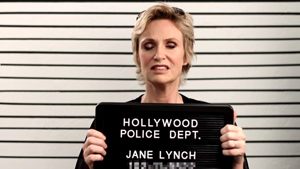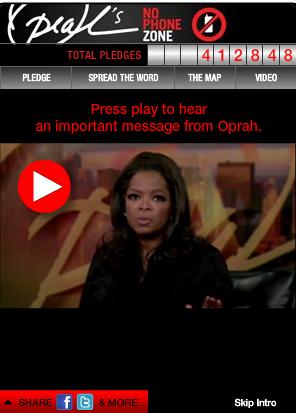 Feb. 4, 2015 Update Please join our friends at Cyberwise.org for a BlogTalk convo with Lauren Galley of Real Talk, Real Teens, Real Issues on Feb. 5, 2015 as texting and driving survivor Liz Marks shares her harrowing firsthand experience that changed her life forever. Parents, this is a media moment where teens might just LISTEN. Tune in for storytelling that can make a difference.
Feb. 4, 2015 Update Please join our friends at Cyberwise.org for a BlogTalk convo with Lauren Galley of Real Talk, Real Teens, Real Issues on Feb. 5, 2015 as texting and driving survivor Liz Marks shares her harrowing firsthand experience that changed her life forever. Parents, this is a media moment where teens might just LISTEN. Tune in for storytelling that can make a difference.
June 8, 2012 Yes, the Glee/Quinn texting while driving accident episode was unrealistic in bounceback/outcome, but I still like the attempt at ’embedding’ messages into programs for awareness. Here’s why.
Jan 21, 2011 In my ad agency days as a creative director, I was a pragmatist known for statements like, “sure it’s clever, but will it WORK?”
When something is literally a life or death proposition (anti-smoking campaigns, disease prevention, substance abuse, road safety) snappy headlines may raise awareness or recall without shifting behavior a smidge. What’s a problem solver to do?
Stanford Persuasion Lab produced a nice Slideshare summary, “Top 10 Mistakes in Behavior Change” with quick tips on process and motivational triggers that serve well when it comes to analysis of the new ‘don’t text while driving’ campaigns of AT&T (The Last Text), LG TextEd (w/Glee’s Jane Lynch) T-Mobile’s new DriveSmart, Oprah’s No Phone Zone, and no doubt many more to come, judging by the deadly statistics on distraction.gov, and liability issues swirling in this mobile sphere.
Many have asked why industry (mobile phone or auto) can’t come up with a location based techno gadget solution akin to a breathalyzer approach that shuts down immediately with the motor-mobile-keyboard engagement…I’m not an engineer, so I’ll leave that ideation and stay with the critical thinking skills of the human brain…
How can we convince teens (and adults, fergawdsakes) that multitasking is an ‘epic fail’ when it comes to lobbing that ‘lol’ response to a pal on the roadway? What works best?
We need to shift justifications away from ‘just this once’ thinking, as in, “Oh, I was at a stop sign” (or stoplight, in traffic, bumper to bumper, insert excuse here) to toss it in the glove box-out of reach-no distractions intervention?
What approach goes beyond lip-service into quantifiable change? Fear-based dramatization? (see BBC shock spot) Real-life sobering experiences? First person narrative PSAs? Humorous education and personal pledges? Peer to peer cajoling and pressure points that pack a punch via social media? School state standards based lesson plans served up in student created style?
 Today we’re showcasing Derek Baird, creator of an open source project based learning approach where KIDS are in the driver’s seat creating their OWN versions of PSAs to engage peers and guide their own discovery…
Today we’re showcasing Derek Baird, creator of an open source project based learning approach where KIDS are in the driver’s seat creating their OWN versions of PSAs to engage peers and guide their own discovery…
FREE, FUN, and best of all, classroom-ready and standards-based, released under a Creative Commons license for any and all to use and share!
The creation of his lesson plan was inspired by an episode of The Oprah Winfrey Show that focused on the dangers of distracted driving. According to a 2009 Pew Internet Study:
- One in three (34%) texting teens ages 16-17 say they have texted while driving. That translates into 26% of all American teens ages 16-17;
- Half (52%) of cell-owning teens ages 16-17 say they have talked on a cell phone while driving. That translates into 43% of all American teens ages 16-17;
- 48% of all teens ages 12-17 say they have been in a car when the driver was texting;
- 40% say they have been in a car when the driver used a cell phone in a way that put themselves or others in danger.
There’s the context, so here we go:
Amy Jussel Interviews Derek Baird: No Phone Zone Standards-Based Lesson Plan For Student PSAs
(FREE, Customizable Curriculum, edu/standards compliant, woohoo!)
Amy Jussel, Shaping Youth: What did you think of the Don’t Text & Drive PSA from the BBC which launched a lot of teen awareness using the fear-based, dramatization platform? Which tactics in your experience w/youth tend to resonate most with kids?
Derek Baird: Well, it got some serious media buzz on both sides of the pond. It shocked people. It may have stopped some people from texting and driving–and that’s good. But in terms of long term behavior change, (see BJFogg’s BehaviorModel.org) I doubt that most people quit texting and driving after seeing the PSA…
Scare tactics, pledges, humor-based PSAs may work for some people, but I think it comes down to educating yourself on the issue, taking personal responsibility and making a decision that you won’t text and drive.
In the end, I think Ms. Winfrey’s education-based approach will have more of a lasting effect than the BBC fear-based PSA.
The BBC PSA was rooted in theory…”this is what could happen if you text and drive” whereas Ms. Winfrey’s approach was rooted in actual events… “this is what happened when teenager Jane Doe was texting and driving.”
When Oprah has young adults sitting on her couch talking about the impactofkillingachild in their community because they were texting and driving, it creates a lasting impression. This is real life. This puts the consequences of texting and driving into a situated context. It’s powerful and emotionallyresonateswithteens.
The most important thing is to shoot straight when talking to kids. When it comes to advertising, they are totally savvy, wired and prepared to ignore your message. You have to be authentic in your messaging and outreach to youth. Don’t talk AT them, instead look for ways that you can involve them in the conversation and delivery of the message.
Amy Jussel, Shaping Youth: How does the length and impact of the AT&T emotional REALITY docu (10min) compare with the LG TextEd Jane Lynch (4min) humor approach? (e.g. some have said the 10min short/docu fm AT&T is “too long” for youth and more for parents, your thoughts?)
Derek Baird: The most important thing is to think about your audience.
 Parents, for example, will consume this information in a different way than their kids will.
Parents, for example, will consume this information in a different way than their kids will.
So for parents, the AT&T, Department of Transportation or National Safety Council resources are probably more useful, substantial and relevant than a JaneLynchTextEdvideo. Youth aren’t going to watch a 10 minute video about texting and driving.
These humor-based campaigns also have a role. I think they are important because they are able to leverage celebrity to shine a light on these issues and make teens pay attention. They are a first step in a bigger conversation. So kudos to Jane Lynch!
The celebrity-based PSAs are great vehicles for raising awareness on these types of issues, but I think that the most effective approach includes taking the initiative to get educated on the cognitiveeffectsoftexting and driving, leading by example and talking to your kids about this issue.
Amy Jussel, Shaping Youth: What do you think of gadget based alarms/shut downs/spy bot-keystroke time tracking-techno solutions deployed as first-strikes for behavioral change?
Derek Baird:I don’t think you can outsource being a parent to technology. These tracking-solutions aren’t going to stop a teen from texting and driving. Time and time again kids have proven to be smarter than technology.
I can guarantee that there are teens out there who will hack their way around these devices designed to prevent them from texting. The low-tech solution is to just borrow a friends phone. There is always a way around these types of things.
Amy Jussel, Shaping Youth: Do you think AT&T and LGTextEd.com should’ve spun off of Oprah’s extensive ‘No Phone Zone’ massive public service campaign rather than impart their own branded messaging? Why/why not?
 Derek Baird:Oprah Winfrey doesn’t have a financial stake or the threat of legislation hanging over her head like the telecoms do/did, so I think that her campaign has a different motivation than the industry campaigns. I think that Oprah was looking at this from a “social good” perspective.
Derek Baird:Oprah Winfrey doesn’t have a financial stake or the threat of legislation hanging over her head like the telecoms do/did, so I think that her campaign has a different motivation than the industry campaigns. I think that Oprah was looking at this from a “social good” perspective.
She knew she could leverage her popularity to shine a light on this issue–not just in the United States, but around the world.
On the other hand, the telecoms have millions and millions of dollars invested in mobile technologies and the last thing they want is the government getting involved and/or passing legislation to combat texting and driving. So they are tackling this from a ‘corporate responsibility’ angle. I’m not saying this is good or bad. I’m just saying there are different motivations for wanting to get involved.
In the end, the most important thing is that people are made aware of this dangerous practice. So if LG TextEd can get older teens to pay attention—great! If Oprah can get the parents of world educated on this issue and get them to talk to their kids–great! If corporate sponsors like Nationwide, Chevy and Sprint want to help Ms. Winfrey get the word out–great!
Amy Jussel, Shaping Youth: How can educators best use your lesson plan to spin off of EACH of these campaigns and create content that’s relevant for their audience by age/stage?
Derek Baird:One thing I was committed to including in my lesson plan was a project-based learning (PBL) activity. Instead of watching a PSA, my lesson plan has kids research the facts on texting and driving, then use their findings to create their own PSA and then finally present their PSA at school, church, scouting or other event.
Instead of being a passive experience, where we are attempting to pour information into their noggin, this seeded serendipity approach guides them towards “discovering” this stuff for themselves.
Amy Jussel, Shaping Youth: When you chose to distribute your lesson plan with a Creative Commons license spring-boarding off of the Oprah ‘No Phone Zone’ campaign to be customizable and free, had you thought about approaching other brands to link up to it and use the tools as part of their platform?
Will it be easy to find as a ‘resource’ on various industry sites as an add-on message for example, or is it housed in edu-tech circles more prominently? (I want to see people get behind all these resources and drive the point home!)
Derek Baird:My motivation to write the lesson plan was sparked by something Ms. Winfrey said during the ‘No Phone Zone’ episode on The Oprah Winfrey Show. In one segment she spoke to a young man who was texting while driving and had killed a man. At one point she asked him “Didn’t they teach you about the dangers of texting and driving in Drivers Ed?”
What Ms. Winfrey didn’t realize is that most schools have terminated drivers education as part of the school curriculum. The other issue is that teachers in public schools don’t teach anything that isn’t aligned to their state standards.
 My primary goals were to create a lesson plan that raised awareness on this issue, make sure that it was standards-based, and to release it under a Creative Commons license so that it would be available for ANY teacher, educator, youth organization or brand.
My primary goals were to create a lesson plan that raised awareness on this issue, make sure that it was standards-based, and to release it under a Creative Commons license so that it would be available for ANY teacher, educator, youth organization or brand.
To be honest, I didn’t have a ‘marketing plan’ for this lesson. It was something I created and intended to distribute throughmyblog and the social publishing platform Scribd.com. The lesson plan was featured by Scribd and EducationWorld and that really fueled the page views.
I thought I’d be lucky to get a couple hundred page views, let alone over 9,000. It took on a life of its own. I’ve found Scribd to be an invaluable resource for getting the word out on this lesson plan, as well as other projects.
My lesson plan won’t be as easy to find as a resource developed by AT&T, LG or everyone else who has jumped on board this issue. They have high profile campaigns, celebrity involvement and a myriad of other resources.
I think what differentiates my lesson plan is that I have aligned it to McRELstandards, so it can be used in the classroom.
This is where a lot of big brands fail in their outreach to educators. They provide great resources, but they don’t align them to state or national standards.
In terms of reaching out to brands, I did approach a contact who works for Ms. Winfrey about adding my lesson plan to her ‘No Phone Zone’ resources, but that never really moved forward.
If there are other brands out there who are interested in using it–go for it! This is an important issue and I’m happy for any brand who wants to use it to do so! This is exactly why I released it under a CreativeCommonslicense.
Amy Jussel, Shaping Youth: Thanks so much, Derek for creating a STANDARDS-BASED option for educators, definitely a “value-add.” 😉
Okay, readers, tweeters, chime in and tell us what’s working and what’s not in your household, your picks and pans of the various campaigns, and most of all…What CHANGED your mind if you were a textaholic turned to no phone zone zeal?
Huge issue, folks…sharing is caring, ‘k? Here’s Derek’s Scrib’d: Use it!
Related Reads, Helpful Resources
1-19-11 T-Mobile & Location Labs Launch DriveSmart To Help You Say “No”
1-18-11 NetFamilyNews: About Teen Drivers, The Last Text
AT&T 10-Minute Documentary Video The Last Text
From YPulse.com:
Texting While Driving: Will Millenials Get The Message?
Can Auto Industry Drive Anti-Texting While Driving Msg?
How Give It A Ponder Could Help Teens Think Twice
From TechCrunch: Pew Internet Reveals What Everyone Already Knows; Teens Like To Text
CrunchGear: Anti-Texting While Driving Message Hits Home (Warning, Graphic!)
MediaPost/Marketing Daily: Gen Y Puts Brakes On Car Ownership










I think these efforts by public figures will help drivers get the message. It has to start with the end user, the driver…deciding not to partake in distracted driving and this will help drive that message home.
I also decided to do something about teen (and adult) distracted driving after my three year old daughter was nearly run down right in front of me by a texting driver. Instead of a shackle that locks down phones and alienates the user (especially teens) I built a tool for teens and their parents called OTTER that is a simple, GPS based, texting auto reply app for smartphones. It also silences call ringtones while driving unless you have a bluetooth enabled. I think if we can empower the individual then change will come to our highways now and not just our laws.
Erik Wood, owner
OTTER LLC
OTTER app
Many people are used using the phone while driving. Not only are they putting themselves at risk. They are also putting the other drivers at risk.
I believe they should be fined or maybe get the license driver suspended.
This is no joke.
They can kill people